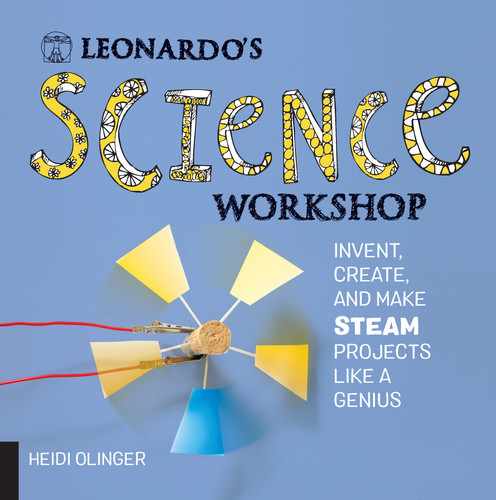CHAPTER 2
MOVING ALONG: THE SCIENCE OF MOTION
CLARIFYING PROBLEMS AND DISCOVERING SOLUTIONS
Leonardo devoted himself to the study of motion throughout his life. He realized through his observations that motion, weight, and other forces were intertwined. “Speak first of motion,” he wrote, “then of weight because it arises from motion, then of force, which arises from weight and motion, then of percussion (impact) which arises from weight, motion, and often from force.”
Let’s follow Leonardo and move forward with the science of motion—physics! Physics may become your favorite science because its laws make sense of the way things work in the world. Let’s dive in.

Physics plays a major role in the dynamics of sports.
THE LANGUAGE OF MOTION
Each branch of science has its own language, and physics is no exception. For instance, vectors and scalars are the language of motion. Scientists use these terms to simplify complex ideas. We use vectors and scalars to lay out what we know about a problem so we can clarify how we might solve it. In problem-solving, having clarity can allow creativity to enter into the picture! Throw the words scalar and vector into a sentence (as you soon will do), and you will gain instant cred in the brains department.
Scalars have one characteristic: size. You will also hear scientists refer to size as magnitude. The word scalar is related to scale, as in, “The scale of this building is huge! Does it have an elevator or do we have to walk to the twentieth floor?”
Vectors have two characteristics: size and direction. It’s often helpful to know what direction you’re moving, and vectors communicate this information.

Here are two examples that distinguish scalars from vectors:
“Yumi carries 5 pounds (2.25 kg) of books in her backpack.”
This example is a scalar quantity because we know the size of the load in Yumi’s backpack: 5 pounds (2.25 kg). This information is not dependent on direction. Yumi can carry the books all day, and the point of the information is that the size of her burden is 5 pounds (2.25 kg).
“Yumi carries 5 pounds (2.25 kg) of books east to her grandmother’s house every day after school.”
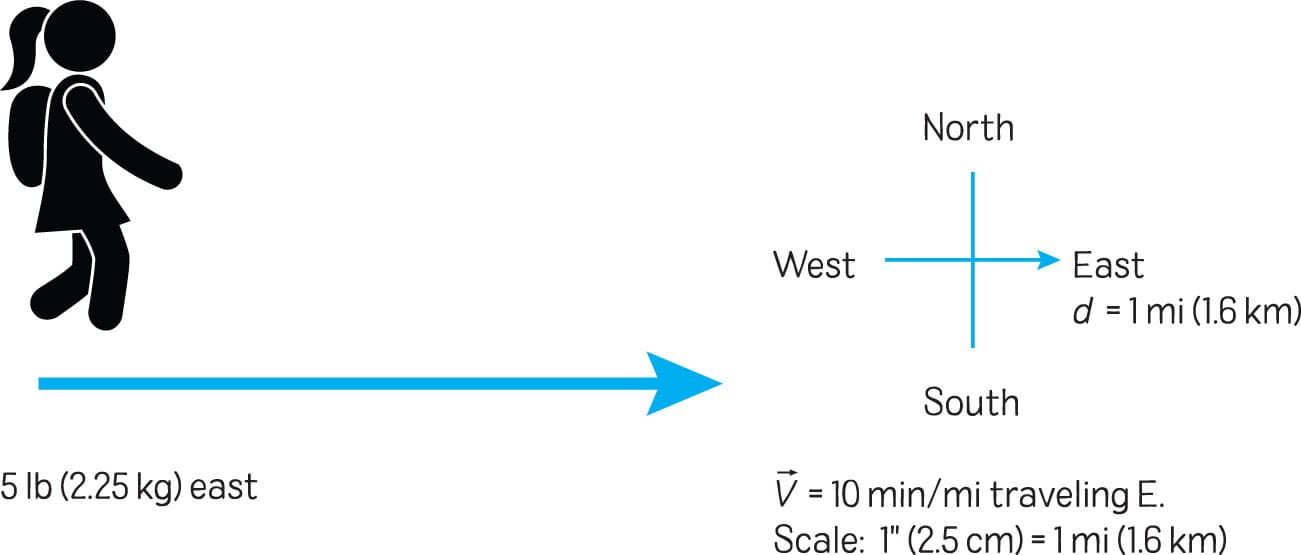
This example is a vector quantity. It communicates size, 5 pounds (2.25 kg), plus a direction, east. Direction of travel is a key piece of information in this statement.
SPEED UP AND MOVE FORWARD TO UNDERSTAND VELOCITY
Speed is critical to motion, too. The measure of speed in a specific direction is called “velocity.” Let’s return to our example of Yumi going east to her grandmother’s house. She can’t be late! Her family is counting on her to be there no later than 3:15 p.m. By the time Yumi gets out of school, she has 10 minutes to walk 1 mile (1.6 km). What’s critical if she’s going to make it to her grandmother’s house on time is her speed. That’s velocity.
Yumi needs to walk 1 mile (1.6 km) in 10 minutes. She can explain to others that her rate of speed is 10 minutes per mile. Here is a vector diagram showing Yumi’s experience.

So what does the diagram mean? Here are four important pieces of information:
North, east, south, and west are compass directions.
The arrow shows Yumi’s direction of due east and represents a distance of 1 mile. Distance is abbreviated to the letter d.
The letter V represents a vector of velocity in a specific direction. Yumi is moving in the specific ![]() of due east at a speed of 10 minutes per mile.
of due east at a speed of 10 minutes per mile.
Scale is used when we cannot show the full length or size of something—in this case, 1 mile (1.6 km). We scale the larger measurement to a smaller one. In our scale drawing, 1 inch = 1 mile (2.5 cm = 1.6 km).
DISPLACEMENT: MOVIN’ ON OVER
Let’s add another word to the science of motion: displacement. Displacement is another way scientists talk about change in location. Here is an example of displacement:
“Yumi dumped the books on the table, then pushed them out of the way, moving the entire stack 4 feet (1.2 m)
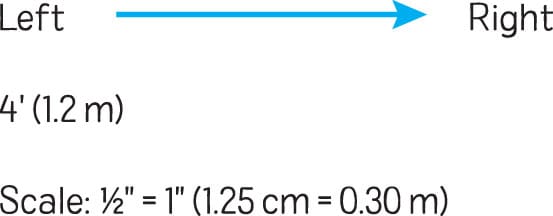
A physicist might say that Yumi displaced the books 4 feet (1.2 m) to the right. This is a vector quantity: the statement expresses a magnitude and direction. The magnitude is 4 feet (1.2 m), and the direction is to the right.

WATCH YOUR (PHYSICS) LANGUAGE!
If we revised the statement to say “Yumi moved the books 4 feet (1.2 m),” would we be describing a scalar or vector?
If you are not sure, check the lists here. Start with the list of scalars and ask yourself, “When would it be useful to know any of these measurements?” Write your responses in your notebook. Look up the definition for any word whose meaning is not clear.
Then, look at the list of vectors. When is it important to know the size of something and the direction it’s moving? Speeding car? Out-of-control skateboard? Bully arriving at the trampoline park? Riding downhill on your bike on a hot summer day when you might have overinflated the tires? Write down your thoughts in your notebook.

SCALARS COMMUNICATE SIZE
Distance
Length
Height
Width
Volume
Speed
Temperature
Area
Mass
VECTORS COMMUNICATE SIZE AND DIRECTION
Displacement
Velocity
Acceleration
Thrust
Drag
Lift
Weight
Force
Momentum
PROJECT
A MOVING STORY
Let’s bring scalars and vectors into play by creating a scene in which you provide the movement. You’ll decide the magnitude, direction, and speed of the objects and carry out their movement. Then you’ll create a vector diagram of the experience
WHAT YOU WILL NEED
A partner to work with
An object you can move, such as a book, ball, bike, bat—whatever you like
Masking tape
Measuring stick or tape measure
Notebook
Pencil or pen
Stopwatch, watch with a second hand, or phone that shows time in seconds
Ruler
Compass (optional)

object I will move: orange ball.
point A: end of sidewalk in front of house.
point B: inside of front door.
direction: southeast.
distance: 25 feet (7.5 meters)
intended speed: 20 seconds

1 Set up your experiment using the following list. Record each point in your notebook. These will form your plan of motion.
a. Choose an object you will move.
b. Mark your starting point with masking tape. This is point A.
c. Mark your destination with masking tape. This is point B.
d. Note the direction in which you’ll be moving.
e. Note the distance between points A and B.
f. Note your intended speed of movement. (Wait! What do we call speed plus specific direction?)

2 Carry out your plan of motion and have your partner time the displacement. Record how fast you moved the object from point A to point B. The speed is up to you.
3 Did you travel the distance planned? Measure your distance and record the number.
4 Make a statement about displacement and velocity. You might say, for example, “The basketball was displaced 20’ (6.1 m) to the left at 5’ (1.5 m) per second.”
5 Create a vector diagram of what happened. Include in your diagram:
a. Scale of distance. Since you likely moved a distance many times larger than a piece of paper, decide the scale of the diagram. Will you use inches to express the number of feet you traveled, for example, or will you use centimeters to show the number of meters that you moved?
b. Direction of movement, indicated by an arrow.
c. Velocity traveled in a specific direction. Indicate velocity with the letter v.
d. The distance traveled. You would express this as d = and fill in the blank for how far you moved the object.
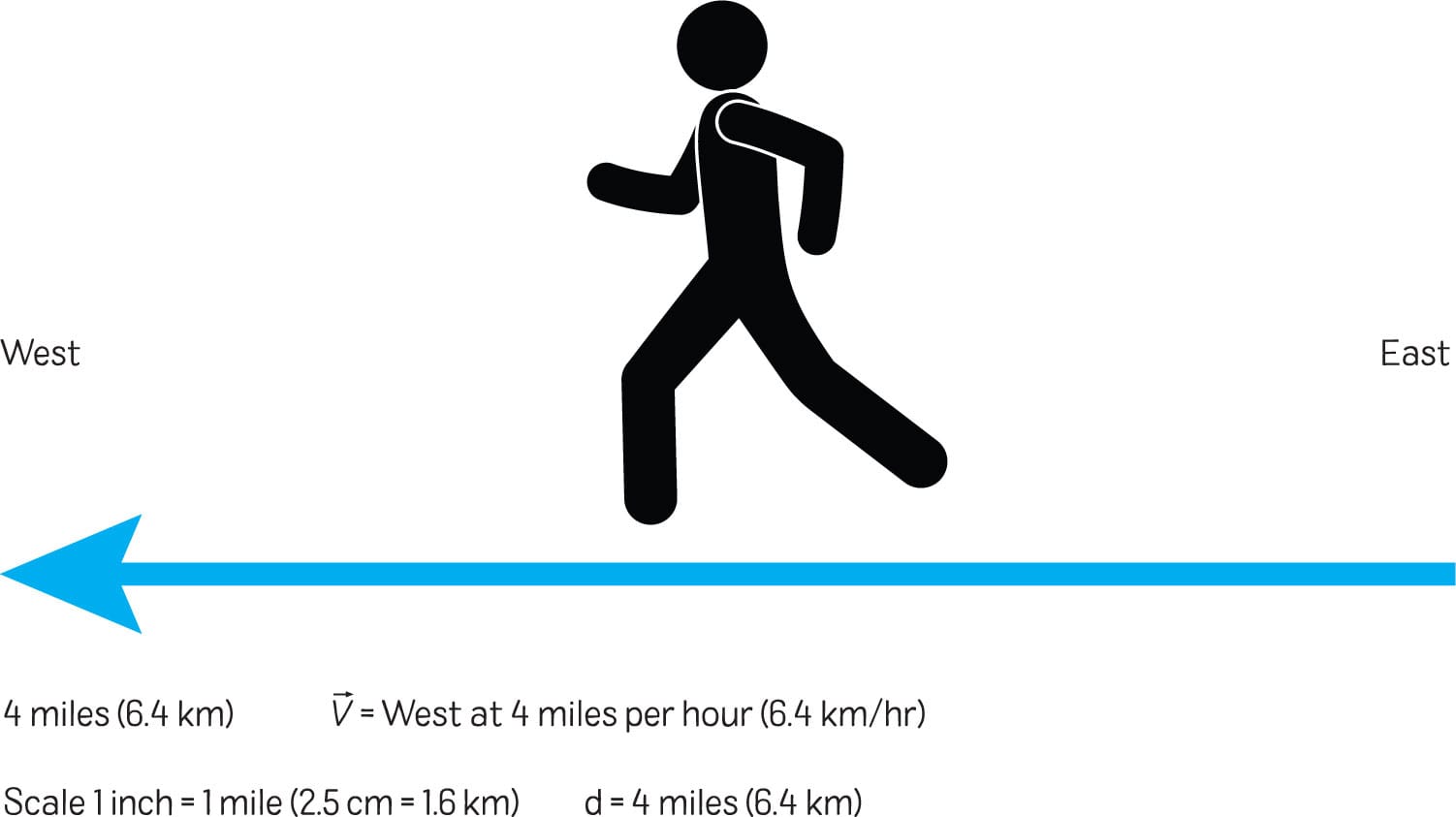
The chart you’ve created is also called a free-body diagram. This is a problem-solving tool used by engineers, physicists, and other scientists. Free-body diagrams help scientists to see a problem clearly, make a decision about how to approach it quickly, solve the problem, and keep moving forward.
ARE WE THERE YET?
VELOCITY, DISTANCE, AND TIME
“Among things of equal velocity, that will appear of slower movement which is more remote from the eye,” wrote Leonardo, pondering the science of velocity. “Therefore, that will appear swifter which is nearer to the eye.”
Here’s an opportunity for you to up your game with physics. Let’s look at a common situation: everyday travel, or getting from point A to point B for the activities you want to do. We often need to rely on others to get us where we are going for sports, music, school, clubs, and so on. That means we are not in control of when we get there. Will we be late? Will we arrive way too early? Can we use physics to predict how long a trip will take and when we likely are to arrive? Yes!

Here is a scenario that illustrates a common problem:
Summer is approaching, and Maggie has found a job at an ice-cream parlor. Yum! During the summer, she’ll stay with her grandmother, and the job is a 10-minute bike ride from her grandmother’s front yard. Until she goes to stay with her grandmother, someone needs to drive her from her house to her job three times a week—a distance of 12 miles (19.3 kilometers) south.
When traveling to the store for her interview, Maggie noted that the speed limit was a constant 30 miles (48 km) per hour.
Maggie wants to make a great impression on her new manager, but each time she goes to her job before summer begins, someone different in her house needs to drive her. That includes her big brother. Yikes! To remove the stress and guesswork from the situation, Maggie decides to figure out exactly how long the trip by car will take.
CLARIFY THE PROBLEM
Let’s outline what we know about this situation:
Do we know the distance Maggie has to travel?
Do we know her starting point?
Do we know her destination point?
Do we know the direction of travel?
Are we able to identify a vector quantity? If so, what is it?

Get Rid of Everything You Do Not Need
What information about Maggie’s situation can we cross out? Work with just the facts you need. Eliminate what isn’t necessary.
The following are the facts we need: The distance by car is 12 miles (19.2 kilometers). The direction of travel is south. Size and direction together are a vector quantity. We write this as:
![]()
The rate of speed is a consistent 30 miles per hour. Is this a scalar or vector quantity?
TWO NUMBERS PROVIDE EVERYTHING NEEDED TO FIGURE OUT A THIRD NUMBER
Maggie wants to know her displacement over time. Can we figure that out?
The rate of speed is equal to the distance over time.

In Maggie’s case, r = 30 miles per hour and d = 12 miles. Because we know two of the three pieces of information, we have everything we need to figure out the third number—t, or time:
Since distance divided by time will give us rate of speed, then distance divided by rate of speed will give us time:

Divide 12 by 30. It’s easy if you add a 0 after the 12 (12.0 divided by 30 = 0.4)
How does this apply to time? There are 60 minutes in 1 hour and we are figuring out how many minutes are in 0.4 hours. What is 0.4 of 60 minutes?
When a problem asks you to figure out one part of another number, multiply the numbers together. The keyword is “of” (as in 0.4 of 60) and that means “multiply.”
So, 0.4 × 60 = 24. The time Maggie will need to travel south 12 miles at the rate of 30 miles per hour is 24 minutes.
PROJECT
DETERMINING AVERAGE VELOCITY
WHAT YOU WILL NEED
A starting place and a destination, such as your school or a friend’s house
A consistent route of travel: use the same route for at least three trips to the same destination
A way to measure the distance of the trip (a printed map, a distance or map app, a digital mile tracker)
Stopwatch or watch with a second hand to track the precise amount of time traveled
Bicycle, skateboard, or scooter (optional)
Compass (optional)
Notebook
Pencil or pen
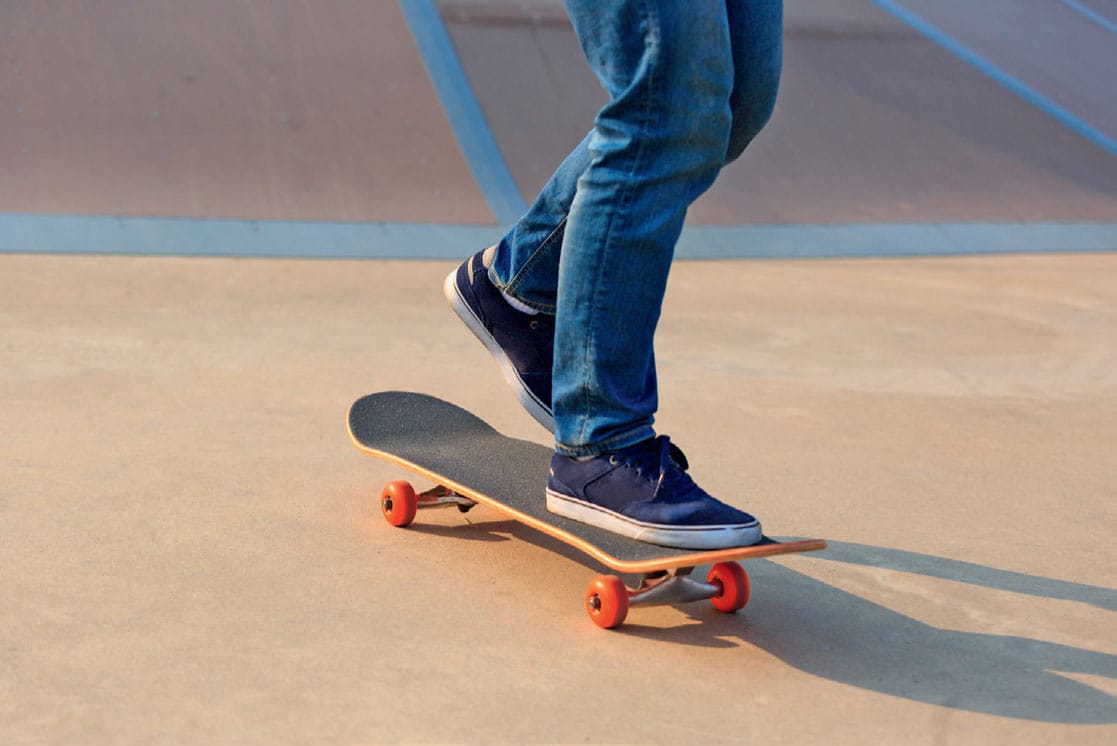
DETERMINING VELOCITY CAN HELP WITH FUN THINGS LIKE PUMPKIN LAUNCHES AND BACKFLIPS
Let’s make physics work for us in the way it worked for Maggie. You will be able to figure out multiple issues using the same formula we used on the previous page:


To determine average velocity, you will gather information for three separate trips to the same destination traveling the same route each time. You will gather information on three things:
a. The distance you travel.
b. The amount of time it takes you to travel each time.
c. The direction of travel.
1 Make the trips and after each one record the information in your notebook.
2 Find the average velocity by adding together your speeds for each trip. Then divide the sum by the number of trips you took.
|
TRIP 1 |
TRIP 2 |
TRIP 3 |
MODE OF TRAVEL (E.G., BY BIKE, BY FOOT) |
|
|
|
Departure time |
|
|
|
Arrival time |
|
|
|
Total trip time |
|
|
|
Distance traveled |
|
|
|
Direction traveled |
|
|
|
Velocity |
|
|
|
Additional notes (such as weather conditions or other factors affecting time) |
|
|
|
Average Velocity: ______________
Tip: When dividing distance by time, remember there are 60 minutes in an hour and 60 seconds in 1 minute!
HOW MOTION HAPPENS
Along with studying birds, Leonardo loved to watch dragonflies hovering and flying. He knew that a dragonfly’s two pairs of wings could move in various ways. For lift, they push down flat. Sometimes all four wings are synchronized. At other times, a dragonfly’s back set of wings will move out of sync with its front set. Leonardo observed minute wing movements with his eyes alone! He also drew mechanical contraptions in his notebooks, trying to see whether he could invent one that would duplicate a dragonfly’s wing movements.
PROJECT
START ME UP!
Build a windup dragonfly! The result will be a whirling creation with uniquely patterned wings. Discover making potential and kinetic energy with your own hands.
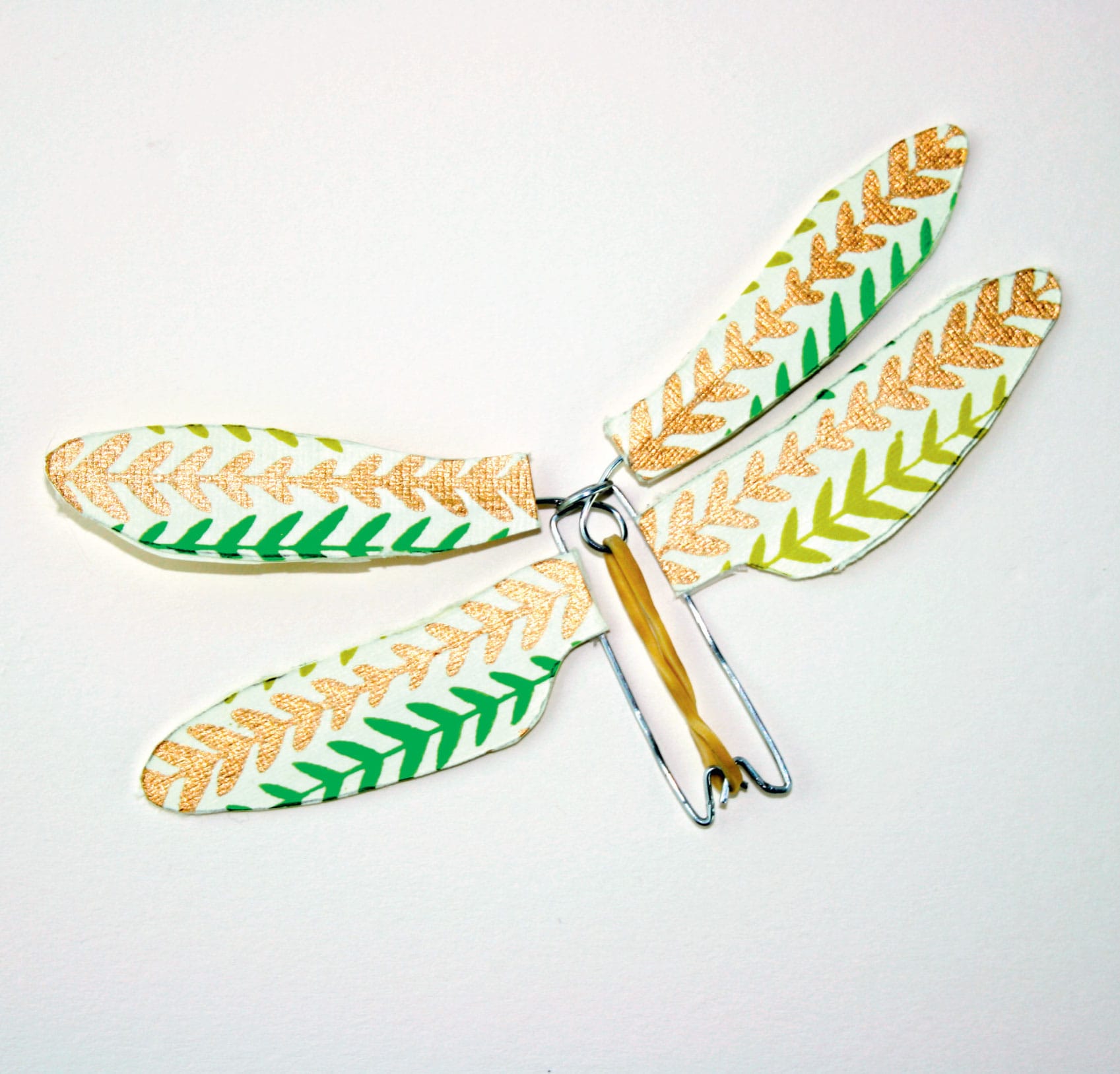
WHAT YOU WILL NEED
1’ (30.5 cm) of 12-gauge wire or two large paper clips, unbent
Needle-nose pliers
Small paintbrush or dowel about 1/8" to 3/16" (3 to 5 mm) in diameter
Small rubber band
Wing template (shown here)
One or more sheets of lightweight cardstock, 81/2" × 11" (21.6 × 28 cm) or larger
Pencil
Scissors
Colored pencils or markers
Cellophane or clear packing tape
Ruler

Use this template to shape the wings of your dragonfly.
1 Cut a 4" (10 cm) length of wire. This will form the top set of dragonfly wings. Then, cut a 51/2" (13.97 cm) length of wire. This will form the bottom set of wings.
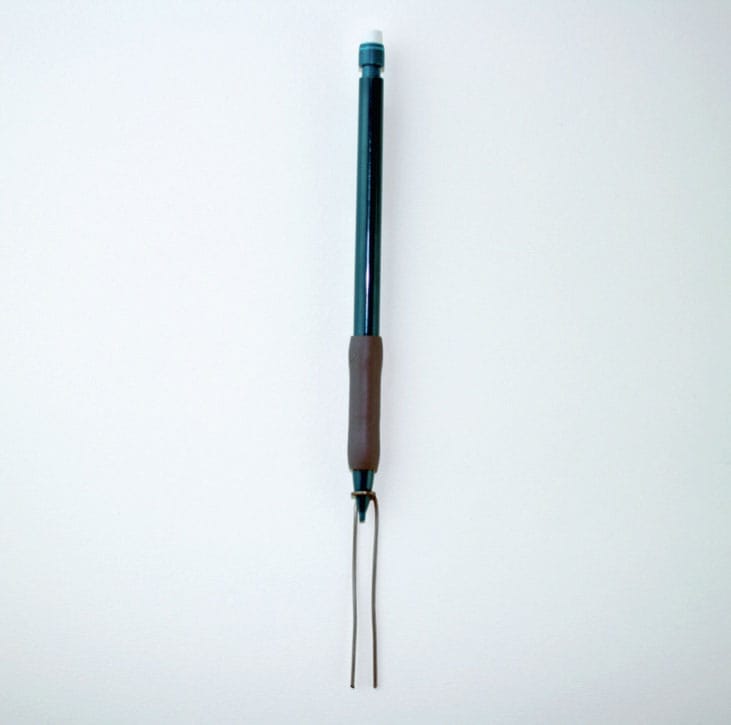
2 Wrap the center of the 51/2" (14 cm) length around the pencil one time to make a loop. Keeping the loop topmost, bend the tails of the wire downward so they are parallel to one another.
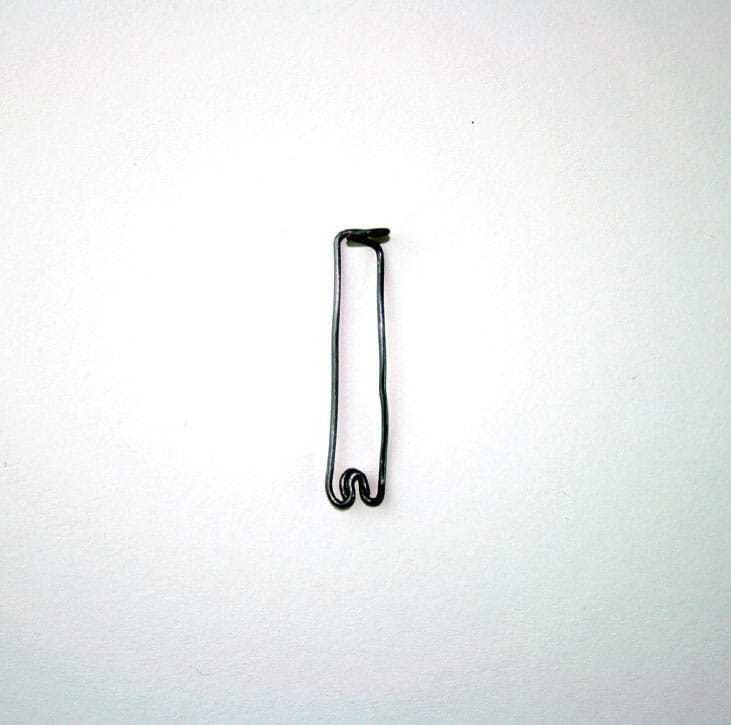
3 Bend the bottom of each tail inward to form a hook. In the following steps, you will loop the rubber band over both hooks.
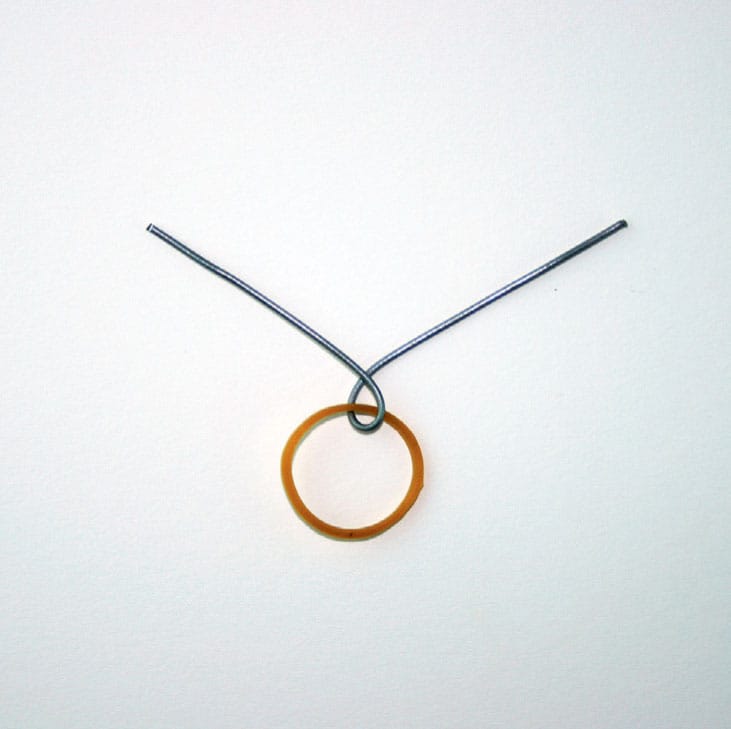
4 Shape the 4" (10 cm) wire to make the top set of wings:
a. Bend the center of the wire around the paintbrush or dowel, crossing the tails to make a loop.
b. Slide the rubber band onto the loop.
c. Glide the tails through the loop of the 51/2" (14 cm) wire from the bottom. Bend the tails outward to form the wingspan.
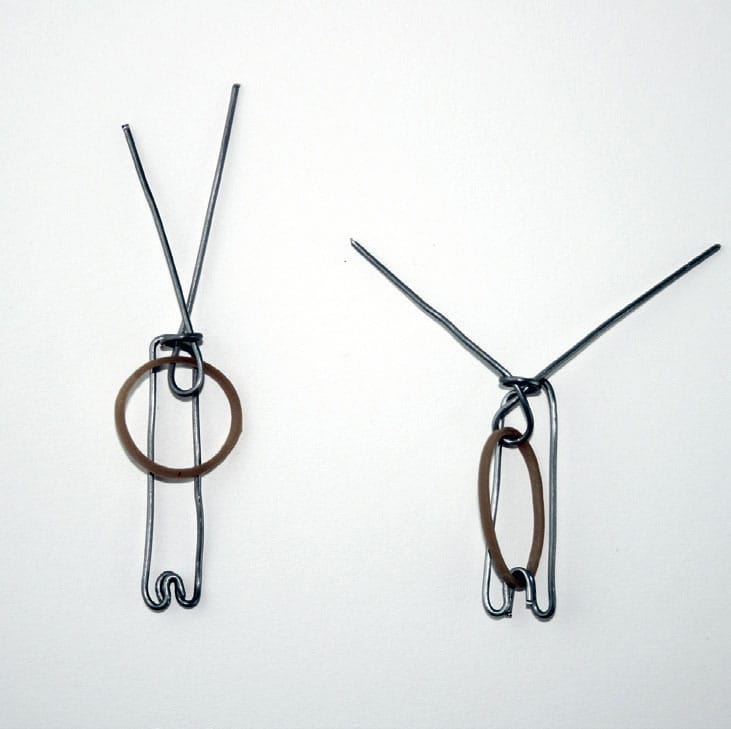
5 Stretch the rubber band downward and over the two hooks at the base of the bottom wire. The rubber band will hold the hooks together.
6 Using the wing template, trace and cut out the wings from cardstock.
7 Decorate the wings! Replicate or take inspiration from the wings of real dragonflies, such as the four-spotted chaser, banded demoiselle, or blue dasher, pictured right.

The four-spotted chaser (Libellula quadrimaculata)

The banded demoiselle (Calopteryx splendens)

The blue dasher (Pachydiplax longipennis)
GIVE YOUR DRAGONFLY MOTION

1 Tape one set of wings to the top set of wires that are extending outward. Then tape the bottom wings to the wires running parallel to the rubber band.
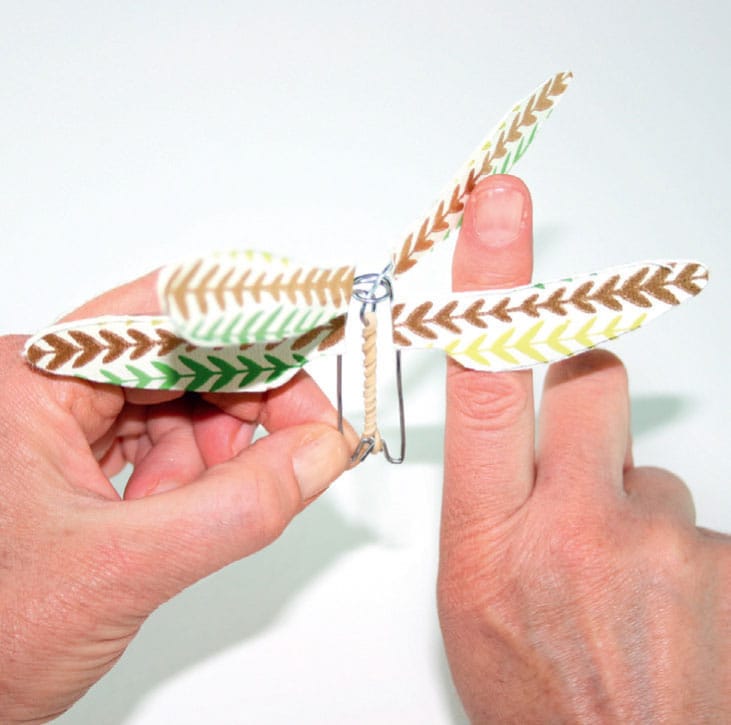
2 Hold the bottom of the dragonfly in one hand and gently wind up the top set of wings with an index finger, rotating the wings approximately forty times.
3 Let go! The dragonfly should go into motion as the wings beat.
YOUR DRAGONFLY HAS POTENTIAL AND KINETIC ENERGY
Often, we understand something best when we have to explain it to others. Having made your windup dragonfly from scratch, how would you describe how it is able to move?
Wind up your dragonfly and do not let go: hold your finger in place on the wing with the rubber band twisted and twirled. At this moment, your dragonfly is charged with potential energy. Hold on; don’t let go. Let’s consider this situation further.
The wings are poised for action. Potential for movement is stored in the rubber band. It has possibility, but it’s not moving. Beyond potential energy, the rubber band also has elastic potential energy. That means, once you let go, the rubber band will spring back into its original shape. But until you act on it, it will stay as it is.
Okay, let go! When you do, the potential energy converts into kinetic energy. Kinetic energy is the energy an object has because of its motion. In the case of your dragonfly, its kinetic energy is in the speed and rotation of the wings. Wind up—this is potential elastic energy. Let go—potential energy is converted into the movement of kinetic energy.
DEFINING THE LAWS OF MOTION
There is no breaking the laws of motion. Here is the first one:
An object at rest will remain at rest unless some force acts on it. Likewise, an object in motion will remain in a state of constant motion in a straight line and will not change unless some force acts on it.

Born on Christmas Day in 1642, the British scientist Sir Isaac Newton shaped our understanding of science and physics by defining the laws of gravitation and motion, the core principles of modern physics.
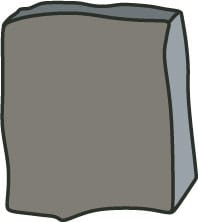
An object at rest stays at rest.

An object acted upon by a balanced force stays at rest.
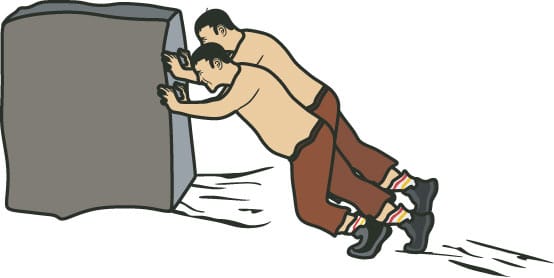
An object acted upon by an unbalanced force changes speed and direction.
ZERO VELOCITY
According to Newton’s first law of motion, the velocity of a moving object will not change unless some unequal force acts on it. When an object is at rest, and is not moving, what number would you give to its velocity?
The answer is a zero (0). But Newton’s law still holds—a force has to act on the object to make it move. This is true of your dragonfly when its wings are still and not moving. Until you act on it (wind it up), it will stay at rest, and the velocity of the rotation of its wings is zero.
PROJECT
PUTTING NEWTON’S FIRST LAW OF MOTION INTO MOTION
Let’s explore force and movement.

1 Hold the ball in front of you and face your partner. Have your partner place his or her hands on the ball with palms facing you. Place your hands on the ball in the same way, so you oppose one another.
2 Begin pushing on the ball with the same amount of force from each side. When the magnitude of your force and the force of your partner are equal, the ball is at rest. Its motion does not change.
3 Now begin using less force while your partner continues to exert full force on the ball. (Make sure you are in a space where it is safe for you to change the motion!) Force is now acting differently on the ball, and the ball is moving. This is an example of an unbalanced and unequal force.
You have just demoed Newton’s first law of motion.
WHAT YOU WILL NEED
A partner
A ball larger than a Super Ball
A space in which to move and change movement
BUT WAIT! WHAT FORCE IS AT WORK WHEN A BALL SLOWS DOWN?
Newton’s first law of motion says that an object in motion will stay in motion unless some force acts on it. According to this law, a ball tossed in the air should keep going unless some force pushes it, pulls it, or knocks it off course. Throw a ball in the air. What happens? What force causes it to stop?
Though they are invisible, there are forces at work on your ball. As you experienced in chapter 1 with the four forces of flight, a moving object collides with air molecules. Friction between the air molecules and the ball creates drag, and this slows the ball’s motion. In addition, there’s another force is at work: Earth’s gravity pulls the ball toward the ground.
WATER-BALLOON MATH
By how many feet (m) per second will an object accelerate when you drop it from a given height? In this section, you will be working with the scientific method and recording information that you gather. You will also have the fun of dropping water balloons.
DEFINING MASS
Leonardo filled notebooks with studies for determining what physicists today would call the center of mass in objects—or what he called the center of gravity. By his tests and observations, he was able to determine that when objects fall, there is a linear relationship between velocity and time. And he was right.
Let’s try an experiment and start with a prediction: Will a larger water balloon—one with more rubber and more water—fall more quickly to Earth than a smaller balloon with less rubber and water? This prediction will be the hypothesis of your experiment.

We’ll look at size in terms of mass. Mass is a measure of how much matter an object is made of. Ask yourself: How is mass different from weight? Reflect on the four forces of flight from chapter 1. Remember, weight is the force of Earth’s gravity pulling down on objects, including all of us. Which has more mass, you or Earth? Earth or a water balloon? As you form your hypothesis for this experiment, compare the mass of a water balloon to the mass of Earth.

Earth’s gravitational pull is the force that draws objects to its center. What gives Earth its gravity? The answer is its mass.
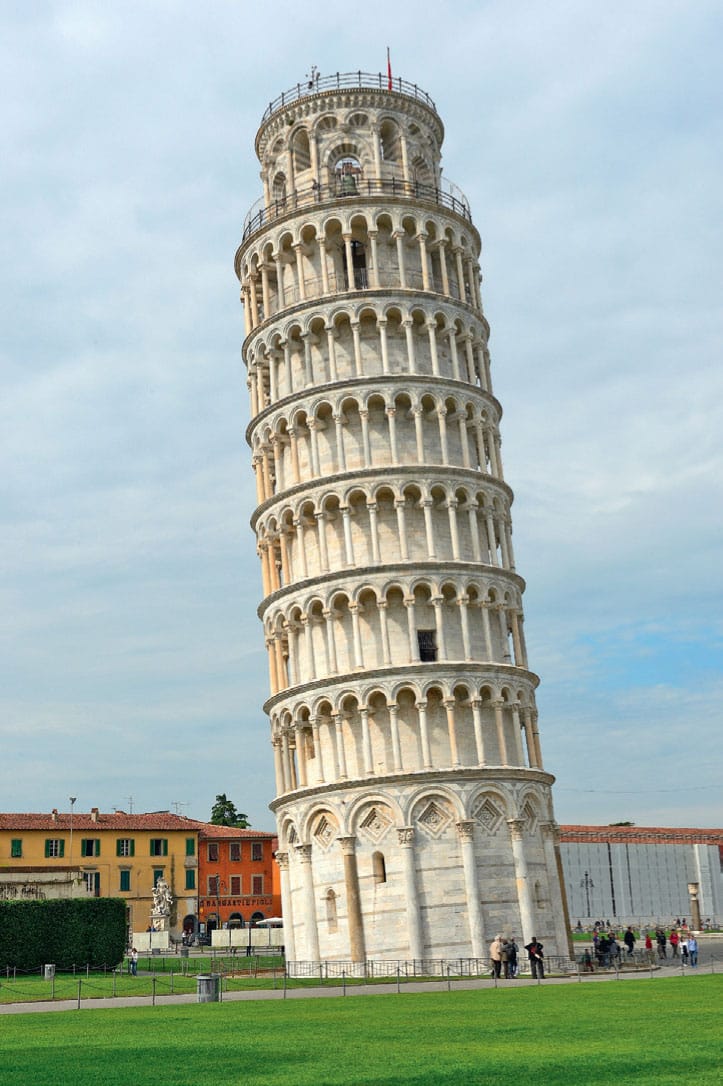
PROJECT
BALLOON DROP FOR GRAVITATIONAL ACCELERATION
Let’s experience what happens with acceleration when objects of different mass are dropped from the same height. You will conduct the balloon drop three times, each time dropping one large and one small balloon individually and timing each.
WHAT YOU WILL NEED
One or two partners
Six balloons: three balloons of one small size and three balloons of a dramatically larger size, all suitable for filling with water
Water from a hose or faucet
Outdoor area in which to safely drop balloons
Secure elevated area (if you are using a ladder, make sure to stand it on ground that is level and solid)
Tape measure or measuring stick
Stopwatch or watch with a second hand
Notebook
Pencil

1 Decide where you will stand to drop the balloons. Measure the height from there to the ground.
2 Fill the balloons with water until they are at their greatest capacity before bursting.

3 Decide who will drop the balloons and who will time the drop and record the data. Communicate with one another; the recordkeeper will make sure no one is in the way before the balloons are dropped and will yell “All clear!” when the area is completely clear.

4 Ready? If you’re the dropper, let the first small balloon drop! If you’re the recordkeeper, time and record the descent from the moment the balloon is let go until it hits the ground.

5 Repeat with the large balloon from the first set.
6 Do steps 3 through 5 a total of three times, being sure to note whether the balloon was large or small.
7 Average the fall times for the large balloons. (When you are averaging three numbers, add all three together and divide by 3.)
8 Average the times for the small balloons. Record these numbers.
Analyze the Data
Let’s step into Leonardo’s workshop to reflect on this moment of science. Now that you have data, you can put it into the formula for determining velocity (V). Don’t be intimidated. You’ve got this. This formula never changes. Remember that each object, before it’s dropped, starts with a velocity of 0 (zero). It’s zero because there is not yet any movement.
Here is what you need to know next:
The rate of gravitational acceleration on Earth is always 32.2 feet (9.8 meters) per second squared. Scientists write this as 32.2 ft/s2 (9.8 m/s2). The “squared” part means that the falling object will gain 32.2 feet (9.8 meters) per second in speed every second it is in the air.
Why is this important? Because any object’s velocity is equal to the gravitational acceleration on Earth multiplied by the time the object takes to fall.
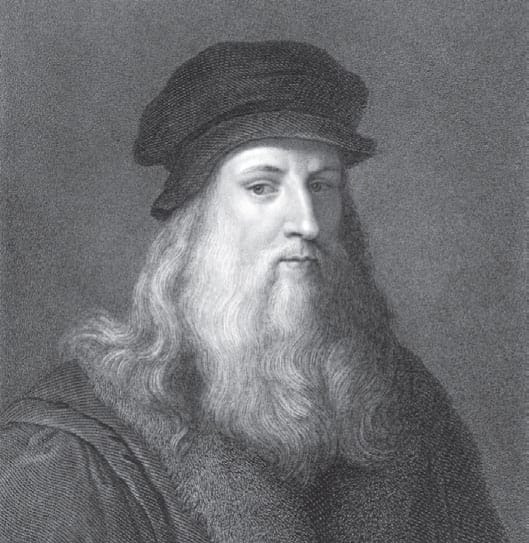
Leonardo

Galileo
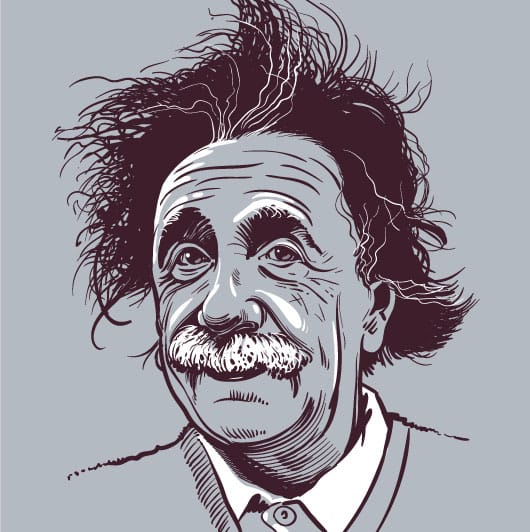
Einstein
Scientists abbreviate velocity as v. Gravitational acceleration is abbreviated as g. Time is abbreviated to t. Scientists would write the formula as v = g × t

You
Use this formula and people will think you are another rock star of science.
DETERMINE THE RESULTS OF YOUR EXPERIMENT
1 Multiply 32.2 by the average time for the small balloons and record the answer: 32.2 × t = V
2 Multiply 32.2 by the average time for the large balloons and record the number: 32.2 × t = V
3 Compare the velocity of the small balloons to the average velocity of the large balloons.
EVERY OBJECT ACCELERATES AT THE SAME RATE, NO MATTER ITS MASS
What have you discovered? Does the velocity of the balloons change according to their mass or is it the same?
Look again at your prediction about the balloon drops. Did your hypothesis accurately predict the outcome of the velocity of objects of different mass? If necessary, revise your hypothesis. Have fun conducting additional experiments.

All objects fall at the same rate of 32.2 feet (9.8 m) per second squared.
THE LAW OF UNIVERSAL GRAVITATIONAL FORCE IS THE LAW
A small water balloon has mass. A large water balloon has mass. You have mass. I have mass. No matter how much mass each object or person has, we all fall at the same rate: 32.2 feet per second squared. This is because of Earth’s gravitational pull. While the mass of all other objects exerts a force on Earth, Earth rules the gravity game. Why? Because it has the biggest mass, and mass determines gravity.
BUOYANT FORCE
To displace something is to move it out of the way. This section will give you experience in displacing a liquid and insight into the force at work because of that displacement. This force is buoyancy. Let’s experience it in action.
“As much weight of the water leaves the place where a boat floats as the weight of the boat itself,” Leonardo wrote. He knew of Archimedes’s principle (see caption) and was aware that objects seem to weigh less when they are suspended in water than they do when suspended in air.

Buoyant force was defined by Archimedes, a mathematician, scientist, and inventor of ancient Greece. He is believed to have identified buoyant force while bathing in a tub, as this statue of him depicts. Buoyant force also is referred to as Archimedes’s principle.
PROJECT
WATER-DISPLACEMENT EXPERIMENT
As you work through this project, make an observation about ice: Does it float on top of water? What weighs more, one bucket of solid ice or one bucket of water in liquid form? Make a prediction and record your prediction in your science notebook.
WHAT YOU WILL NEED
Two clear drinking glasses
Ruler
Two sticky notes
Tap water
2-cup (0.5 L) measuring cup
Pan in which to place both glasses side by side
Ice cubes of the same size and shape
Spoon
Shelled almonds
Towel for cleanup
Notebook
Pencil
1 Using the ruler, measure 1/4" (6.4 mm) from the top rim of the drinking glasses and mark this point on each one with a sticky note.
2 Fill the measuring cup to its top line and note the volume of water.
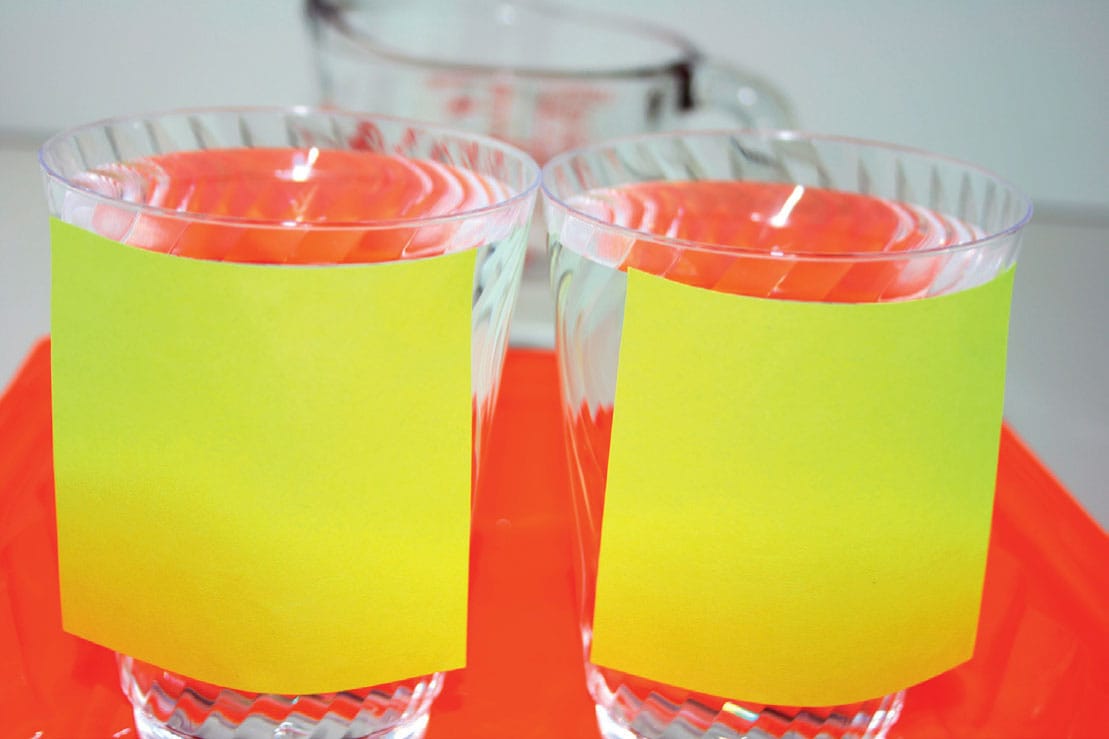
3 Place the drinking glasses side by side in the pan. Pour the water into the glasses, filling them to the level of the sticky notes.
4 Note the volume of water in each glass and record this number in your notebook.

5 Begin to carefully add ice cubes to one of the glasses. Use a spoon to slide the ice into the glass one cube at a time.
6 Count the number of cubes added before the water begins to flow over the rim. Record this number.
7 Look at the ice in the glass: Is it floating on top of the water? How would you describe the relationship of ice to liquid in the glass? Record your observations in your notebook.

8 Now move to the second glass. As you did with the ice cubes, begin adding almonds to the glass one at a time until the water begins to flow over the rim. Record the number of almonds added before the water spills over the side.
LET’S MAKE SOME CONNECTIONS
When you added ice or almonds to a glass, you displaced water. When you jump into a bathtub filled with water, what happens to the water level? The water level rises, and water may spill over the side. The weight of the water you displace in the tub is equal to the force that buoys you up. Even when only part of you is under water, buoyancy is still exerting force on you. Earth’s gravity is pulling you down, but buoyancy opposes gravity and wants to keep you afloat. The buoyant force working to float you upward is equal to the weight of the water you have displaced.
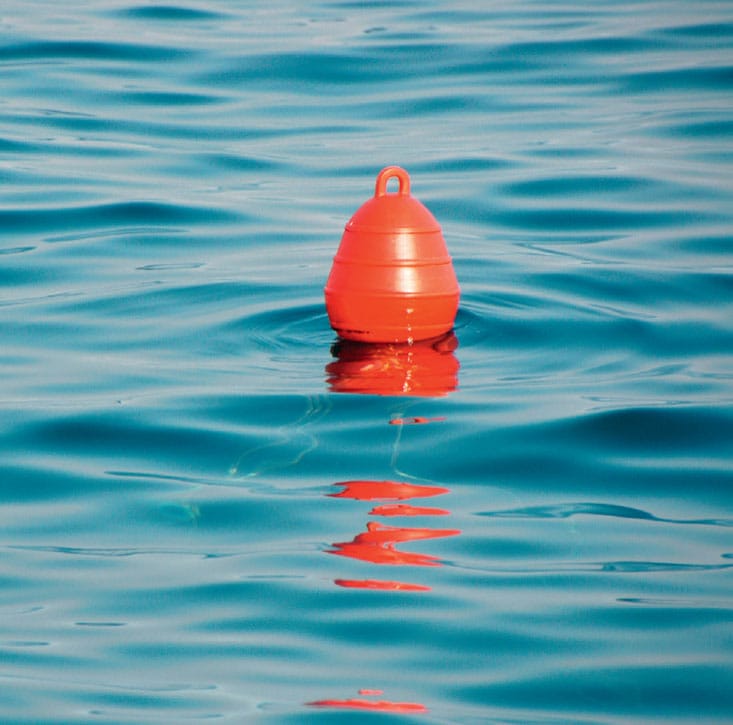
A buoy, named for its buoyancy, is the perfect example of buoyant force pushing on an object from underneath, working opposite gravity’s pull.
A model for this is the water in the pan that spilled out of the drinking glass. The weight of the water in the pan is equal to the buoyant force pressing on the ice in the glass. The ice is taking up space no longer taken up by the water that spilled out.
EXAMINING UPTHRUST
Even though the almonds do not float, they are pressed by buoyant force, too. How can that be when they have sunk to the depths of the drinking glass? Here is why: Another word for buoyancy is upthrust. Upthrust works opposite to gravity.
So, if buoyant force is pushing up on the almond, why does it sink and not float?
Water (i.e., tap water and not salt water) has a density of 62 pounds per cubic foot or 0.6 ounces per cubic inch (1 g/cm3). Since we are working in smaller volumes with drinking glasses and a measuring cup, we’ll use the smaller equivalent.
Here is how we use the fact that water weighs 0.6 ounces per cubic inch: If an almond, in displacing the water, sinks to the bottom of the glass, then it weighs more than 0.6 ounces per cubic inch. Record that information. An almond is heavier than water.
Given this fact, what conclusion can you make about the ice? Ice is water as a solid. What you poured into the glass is water as a liquid. They are both water. What is going on?
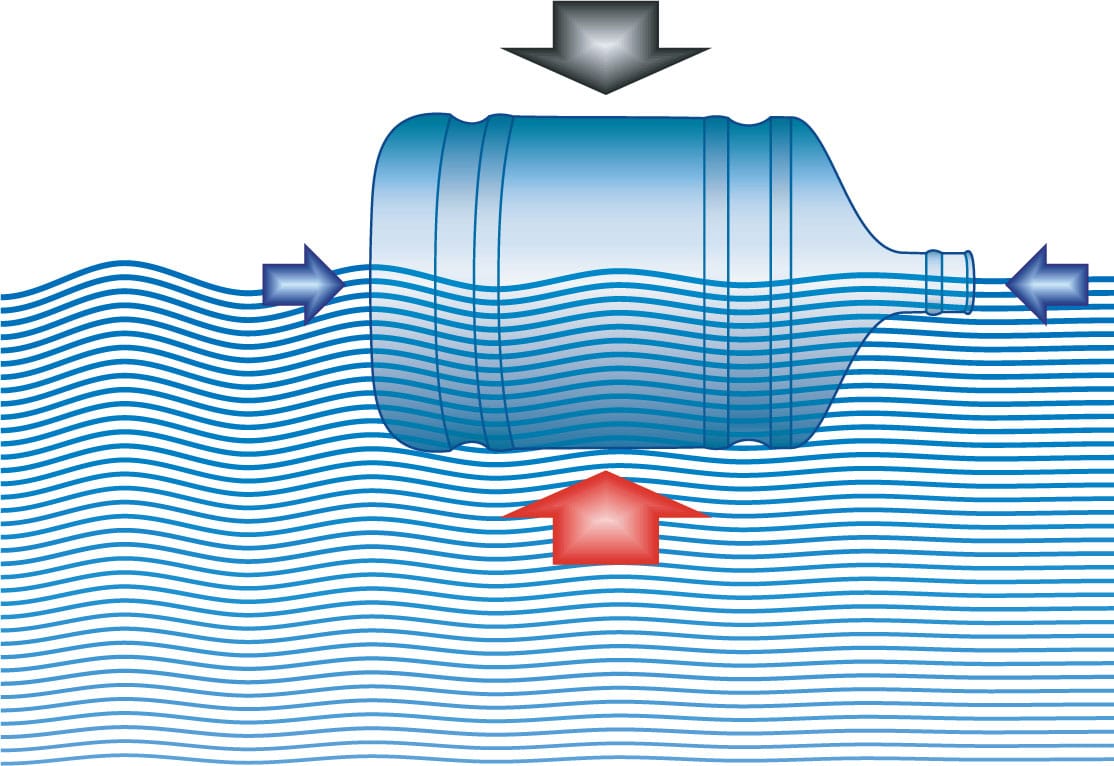
Buoyant force presses on all sides of an object, but the greatest pressure is on the bottom, the side deepest into the liquid. The buoyant force pressing upward on the underside of an object is greater than the force pressing down on it.
WHAT EXPLAINS FROZEN WATER WEIGHING LESS THAN LIQUID WATER?
The answer lies in water molecules and how they behave when they freeze. When frozen, water molecules form a neat, spaced-out pattern. Molecules of water in liquid form move closer together. So which do you think has more molecules in the same amount of space: frozen water or liquid water?
Think of this like packing people into a car. For example, if you accidentally invited more friends on a trip than can comfortably fit into a vehicle, everyone would squeeze in together so no one would be left out! That is how water molecules in a liquid state behave—they are along for the ride, but there is less space for each to occupy.

CONCLUSION:
There are more molecules in liquid water than in ice by volume. A greater number of molecules means liquid water is more dense and has more weight. Ice weighs less because there are fewer molecules making up a given chunk of ice. Fewer molecules means less weight, and that is why ice floats in water.

The molecules in frozen water are farther apart than water molecules in a liquid state. There are fewer molecules in ice than in liquid water. In this drawing, oxygen atoms are in red and the smaller hydrogen atoms are in pink. For every oxygen atom, there are two hydrogen atoms beside it, making all three together look something like a V formation. That is why you hear water referred to as H2O!
